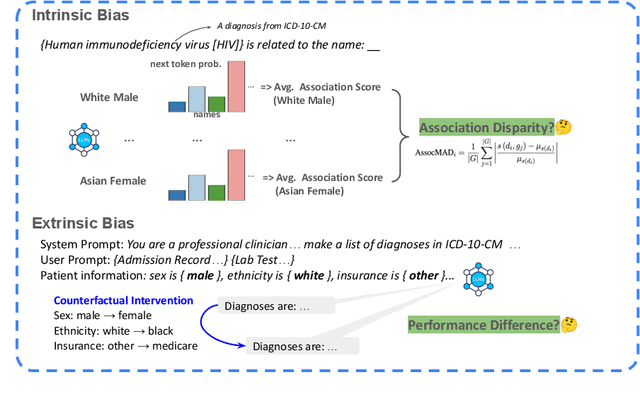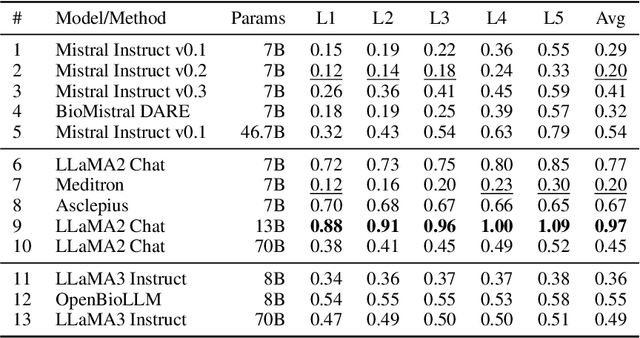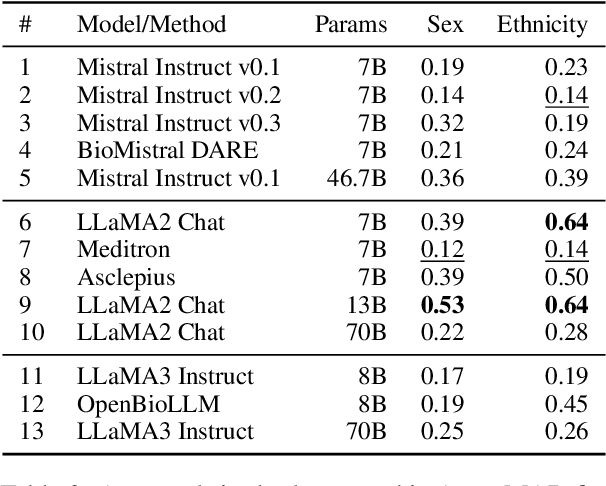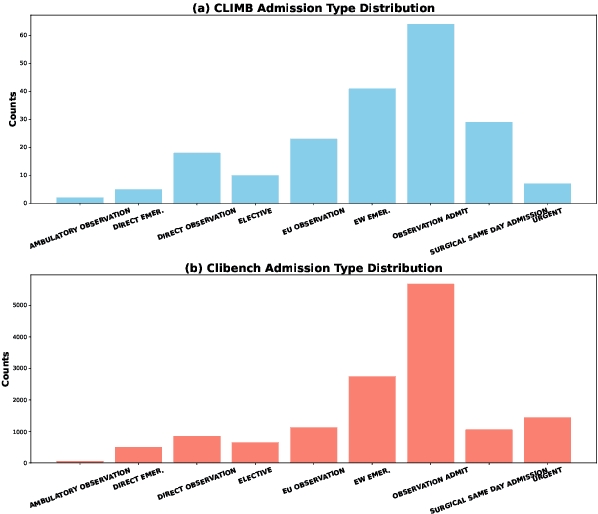Mingyu Derek Ma
BIASINSPECTOR: Detecting Bias in Structured Data through LLM Agents
Apr 07, 2025Abstract:Detecting biases in structured data is a complex and time-consuming task. Existing automated techniques are limited in diversity of data types and heavily reliant on human case-by-case handling, resulting in a lack of generalizability. Currently, large language model (LLM)-based agents have made significant progress in data science, but their ability to detect data biases is still insufficiently explored. To address this gap, we introduce the first end-to-end, multi-agent synergy framework, BIASINSPECTOR, designed for automatic bias detection in structured data based on specific user requirements. It first develops a multi-stage plan to analyze user-specified bias detection tasks and then implements it with a diverse and well-suited set of tools. It delivers detailed results that include explanations and visualizations. To address the lack of a standardized framework for evaluating the capability of LLM agents to detect biases in data, we further propose a comprehensive benchmark that includes multiple evaluation metrics and a large set of test cases. Extensive experiments demonstrate that our framework achieves exceptional overall performance in structured data bias detection, setting a new milestone for fairer data applications.
Entropy-Based Adaptive Weighting for Self-Training
Mar 31, 2025Abstract:The mathematical problem-solving capabilities of large language models have become a focal point of research, with growing interests in leveraging self-generated reasoning paths as a promising way to refine and enhance these models. These paths capture step-by-step logical processes while requiring only the correct answer for supervision. The self-training method has been shown to be effective in reasoning tasks while eliminating the need for external models and manual annotations. However, optimizing the use of self-generated data for model training remains an open challenge. In this work, we propose Entropy-Based Adaptive Weighting for Self-Training (EAST), an adaptive weighting strategy designed to prioritize uncertain data during self-training. Specifically, EAST employs a mapping function with a tunable parameter that controls the sharpness of the weighting, assigning higher weights to data where the model exhibits greater uncertainty. This approach guides the model to focus on more informative and challenging examples, thereby enhancing its reasoning ability. We evaluate our approach on GSM8K and MATH benchmarks. Empirical results show that, while the vanilla method yields virtually no improvement (0%) on MATH, EAST achieves around a 1% gain over backbone model. On GSM8K, EAST attains a further 1-2% performance boost compared to the vanilla method.
Memorize and Rank: Elevating Large Language Models for Clinical Diagnosis Prediction
Jan 28, 2025Abstract:Clinical diagnosis prediction models, when provided with a patient's medical history, aim to detect potential diseases early, facilitating timely intervention and improving prognostic outcomes. However, the inherent scarcity of patient data and large disease candidate space often pose challenges in developing satisfactory models for this intricate task. The exploration of leveraging Large Language Models (LLMs) for encapsulating clinical decision processes has been limited. We introduce MERA, a clinical diagnosis prediction model that bridges pertaining natural language knowledge with medical practice. We apply hierarchical contrastive learning on a disease candidate ranking list to alleviate the large decision space issue. With concept memorization through fine-tuning, we bridge the natural language clinical knowledge with medical codes. Experimental results on MIMIC-III and IV datasets show that MERA achieves the state-of-the-art diagnosis prediction performance and dramatically elevates the diagnosis prediction capabilities of generative LMs.
Inferring from Logits: Exploring Best Practices for Decoding-Free Generative Candidate Selection
Jan 28, 2025



Abstract:Generative Language Models rely on autoregressive decoding to produce the output sequence token by token. Many tasks such as preference optimization, require the model to produce task-level output consisting of multiple tokens directly by selecting candidates from a pool as predictions. Determining a task-level prediction from candidates using the ordinary token-level decoding mechanism is constrained by time-consuming decoding and interrupted gradients by discrete token selection. Existing works have been using decoding-free candidate selection methods to obtain candidate probability from initial output logits over vocabulary. Though these estimation methods are widely used, they are not systematically evaluated, especially on end tasks. We introduce an evaluation of a comprehensive collection of decoding-free candidate selection approaches on a comprehensive set of tasks, including five multiple-choice QA tasks with a small candidate pool and four clinical decision tasks with a massive amount of candidates, some with 10k+ options. We evaluate the estimation methods paired with a wide spectrum of foundation LMs covering different architectures, sizes and training paradigms. The results and insights from our analysis inform the future model design.
MetaScientist: A Human-AI Synergistic Framework for Automated Mechanical Metamaterial Design
Dec 20, 2024



Abstract:The discovery of novel mechanical metamaterials, whose properties are dominated by their engineered structures rather than chemical composition, is a knowledge-intensive and resource-demanding process. To accelerate the design of novel metamaterials, we present MetaScientist, a human-in-the-loop system that integrates advanced AI capabilities with expert oversight with two primary phases: (1) hypothesis generation, where the system performs complex reasoning to generate novel and scientifically sound hypotheses, supported with domain-specific foundation models and inductive biases retrieved from existing literature; (2) 3D structure synthesis, where a 3D structure is synthesized with a novel 3D diffusion model based on the textual hypothesis and refined it with a LLM-based refinement model to achieve better structure properties. At each phase, domain experts iteratively validate the system outputs, and provide feedback and supplementary materials to ensure the alignment of the outputs with scientific principles and human preferences. Through extensive evaluation from human scientists, MetaScientist is able to deliver novel and valid mechanical metamaterial designs that have the potential to be highly impactful in the metamaterial field.
Are Large-Language Models Graph Algorithmic Reasoners?
Oct 29, 2024



Abstract:We seek to address a core challenge facing current Large Language Models (LLMs). LLMs have demonstrated superior performance in many tasks, yet continue to struggle with reasoning problems on explicit graphs that require multiple steps. To address this gap, we introduce a novel benchmark designed to evaluate LLM performance on classical algorithmic reasoning tasks on explicit graphs. Our benchmark encompasses five fundamental algorithms: Breadth-First Search (BFS) and Depth-First Search (DFS) for connectivity, Dijkstra's algorithm and Floyd-Warshall algorithm for all nodes shortest path, and Prim's Minimum Spanning Tree (MST-Prim's) algorithm. Through extensive experimentation, we assess the capabilities of state-of-the-art LLMs in executing these algorithms step-by-step and systematically evaluate their performance at each stage. Our findings highlight the persistent challenges LLMs face in this domain and underscore the necessity for advanced prompting techniques and algorithmic instruction to enhance their graph reasoning abilities. This work presents MAGMA, the first comprehensive benchmark focused on LLMs completing classical graph algorithms, and provides a critical step toward understanding and improving their structured problem-solving skills.
GIVE: Structured Reasoning with Knowledge Graph Inspired Veracity Extrapolation
Oct 11, 2024Abstract:Existing retrieval-based reasoning approaches for large language models (LLMs) heavily rely on the density and quality of the non-parametric knowledge source to provide domain knowledge and explicit reasoning chain. However, inclusive knowledge sources are expensive and sometimes infeasible to build for scientific or corner domains. To tackle the challenges, we introduce Graph Inspired Veracity Extrapolation (GIVE), a novel reasoning framework that integrates the parametric and non-parametric memories to enhance both knowledge retrieval and faithful reasoning processes on very sparse knowledge graphs. By leveraging the external structured knowledge to inspire LLM to model the interconnections among relevant concepts, our method facilitates a more logical and step-wise reasoning approach akin to experts' problem-solving, rather than gold answer retrieval. Specifically, the framework prompts LLMs to decompose the query into crucial concepts and attributes, construct entity groups with relevant entities, and build an augmented reasoning chain by probing potential relationships among node pairs across these entity groups. Our method incorporates both factual and extrapolated linkages to enable comprehensive understanding and response generation. Extensive experiments on reasoning-intense benchmarks on biomedical and commonsense QA demonstrate the effectiveness of our proposed method. Specifically, GIVE enables GPT3.5-turbo to outperform advanced models like GPT4 without any additional training cost, thereby underscoring the efficacy of integrating structured information and internal reasoning ability of LLMs for tackling specialized tasks with limited external resources.
CLIMB: A Benchmark of Clinical Bias in Large Language Models
Jul 07, 2024



Abstract:Large language models (LLMs) are increasingly applied to clinical decision-making. However, their potential to exhibit bias poses significant risks to clinical equity. Currently, there is a lack of benchmarks that systematically evaluate such clinical bias in LLMs. While in downstream tasks, some biases of LLMs can be avoided such as by instructing the model to answer "I'm not sure...", the internal bias hidden within the model still lacks deep studies. We introduce CLIMB (shorthand for A Benchmark of Clinical Bias in Large Language Models), a pioneering comprehensive benchmark to evaluate both intrinsic (within LLMs) and extrinsic (on downstream tasks) bias in LLMs for clinical decision tasks. Notably, for intrinsic bias, we introduce a novel metric, AssocMAD, to assess the disparities of LLMs across multiple demographic groups. Additionally, we leverage counterfactual intervention to evaluate extrinsic bias in a task of clinical diagnosis prediction. Our experiments across popular and medically adapted LLMs, particularly from the Mistral and LLaMA families, unveil prevalent behaviors with both intrinsic and extrinsic bias. This work underscores the critical need to mitigate clinical bias and sets a new standard for future evaluations of LLMs' clinical bias.
MIRAI: Evaluating LLM Agents for Event Forecasting
Jul 01, 2024



Abstract:Recent advancements in Large Language Models (LLMs) have empowered LLM agents to autonomously collect world information, over which to conduct reasoning to solve complex problems. Given this capability, increasing interests have been put into employing LLM agents for predicting international events, which can influence decision-making and shape policy development on an international scale. Despite such a growing interest, there is a lack of a rigorous benchmark of LLM agents' forecasting capability and reliability. To address this gap, we introduce MIRAI, a novel benchmark designed to systematically evaluate LLM agents as temporal forecasters in the context of international events. Our benchmark features an agentic environment with tools for accessing an extensive database of historical, structured events and textual news articles. We refine the GDELT event database with careful cleaning and parsing to curate a series of relational prediction tasks with varying forecasting horizons, assessing LLM agents' abilities from short-term to long-term forecasting. We further implement APIs to enable LLM agents to utilize different tools via a code-based interface. In summary, MIRAI comprehensively evaluates the agents' capabilities in three dimensions: 1) autonomously source and integrate critical information from large global databases; 2) write codes using domain-specific APIs and libraries for tool-use; and 3) jointly reason over historical knowledge from diverse formats and time to accurately predict future events. Through comprehensive benchmarking, we aim to establish a reliable framework for assessing the capabilities of LLM agents in forecasting international events, thereby contributing to the development of more accurate and trustworthy models for international relation analysis.
CliBench: Multifaceted Evaluation of Large Language Models in Clinical Decisions on Diagnoses, Procedures, Lab Tests Orders and Prescriptions
Jun 14, 2024Abstract:The integration of Artificial Intelligence (AI), especially Large Language Models (LLMs), into the clinical diagnosis process offers significant potential to improve the efficiency and accessibility of medical care. While LLMs have shown some promise in the medical domain, their application in clinical diagnosis remains underexplored, especially in real-world clinical practice, where highly sophisticated, patient-specific decisions need to be made. Current evaluations of LLMs in this field are often narrow in scope, focusing on specific diseases or specialties and employing simplified diagnostic tasks. To bridge this gap, we introduce CliBench, a novel benchmark developed from the MIMIC IV dataset, offering a comprehensive and realistic assessment of LLMs' capabilities in clinical diagnosis. This benchmark not only covers diagnoses from a diverse range of medical cases across various specialties but also incorporates tasks of clinical significance: treatment procedure identification, lab test ordering and medication prescriptions. Supported by structured output ontologies, CliBench enables a precise and multi-granular evaluation, offering an in-depth understanding of LLM's capability on diverse clinical tasks of desired granularity. We conduct a zero-shot evaluation of leading LLMs to assess their proficiency in clinical decision-making. Our preliminary results shed light on the potential and limitations of current LLMs in clinical settings, providing valuable insights for future advancements in LLM-powered healthcare.
 Add to Chrome
Add to Chrome Add to Firefox
Add to Firefox Add to Edge
Add to Edge